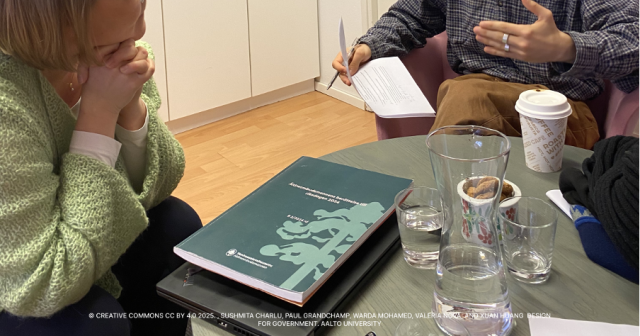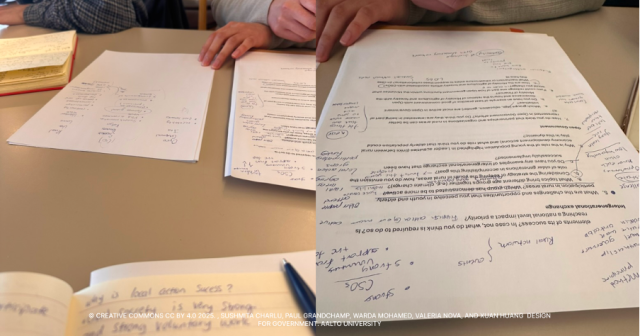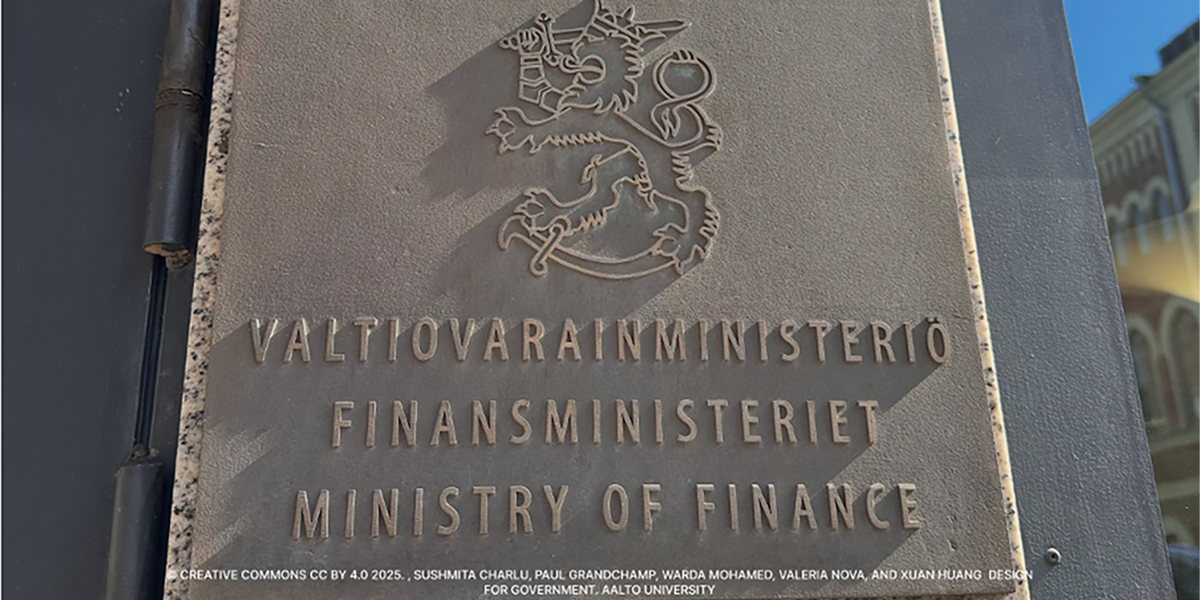This blog post reports on work-in-progress within the DfG course! The post is written by group 2 dealing with the Ministry of Finance’s brief on ‘Open Governance’. The group includes Sushmita Charlu from Collaborative and Industrial Design, Paul Grandchamp from Creative Sustainability program (Aalto ARTS), Valeria Nova from Creative Sustainability program (Aalto ARTS), Warda Mohamed from Collaborative and Industrial Design and Xuan Huang from Environmental Design and Creative Sustainability (Aalto ARTS).
Written by: Warda Mohamed
Following our mid-term presentation, we launched into the next phase of our project, and for this, we decided to focus on the notion of intergenerational collaboration. Over the following weeks, our goal was to explore attitudes toward inclusion, dialogue, and open government as well as to explore the possibilities of intergenerational collaboration between youth and the elderly. We contacted the most relevant organizations to interview, and despite the time constraints, we managed to get responses from a variety of organizations on such short notice.
Our first interview was with Ira Alanko from the Ministry of Finance, one of our project partners. Ira joined us in the round table discussion that we held previously as part of the course. She provided an overview of the principles and structure of Open Government, including its key actors and operational dynamics. This served as a strong starting point to understand their roles and responsibilities of Open Government.
Following this interview, we conducted 11 interviews with people from different organizations, including the Swedish Pensioners Alliance, Helsinki Elderly Citizens Council, Helsinki Youth Citizens Council, Valli, Ministry of Agriculture, City of Helsinki, Jade Community, and more. Each interview provided different and valuable perspectives on the ageing population and intergenerational engagement.

Figure 1. Interview with an expert of the Swedish-speaking Pensioners’ Association.
While conducting the interviews, we quickly realised that many of the interviewees were not entirely familiar with the concept of Open Government. Their awareness ranged from not having heard of it or not knowing what it means, to somewhat knowing about it, and even having a personal interest in it. This allowed us to adapt our approach during the interviews. For example, we began introducing a new question that we didn’t have before: “Have you heard of Open Government? What comes to your mind when you hear open government?” Not only did it help warm up the conversation and allow participants to reflect on how they might relate to the concept, but it also eliminated the assumption that organizations were already familiar with Open Government.
As we had many interviews back-to-back, it was easy to lose track. One practice that helped us was debriefing after each interview. We would sit down together and discuss our insights while they were still fresh in our minds. Another helpful approach was using a semi-structured interview method, which means we prepared a set of guiding questions in advance but allowed for flexibility in the conversation. This made the conversations more comfortable and allowed unexpected topics to emerge, and things we hadn’t thought of would come up. One of the most important lessons of doing field work was asking follow-up questions, seeking clarity on what we didn’t understand, and always asking for examples.

Figure 2. Synthesize all the insights.
One valuable piece of feedback that we received from many of our interviewees was that our conversations made them think more deeply about the topic of Open Government. We also found it significant that many organizations are already advocating and helping their communities and applying principles like Open Government. For example, they can provide accessible language to their communities and encourage participation. Organizations often serve as a bridge between citizens and the government, which tends to increase trust by making people feel heard.
Despite each interview offering a lot of valuable insights, a few topics stood out. One of them is about The Future: who is the future for? For the youth? We often think about the future for youth, but what about the elderly’s future? A representative from Valli (The Finnish Union for Senior Services) made an important point: Retirement can be a very long phase, sometimes over 40 years. “You wouldn’t compare a 1-year-old to a 40-year-old,” she said. She emphasized that both younger and older generations have a future. “Finland is a good place to grow up and grow old.” On the other hand, we discovered that for the youth, “the future” is often viewed in very short-term ways. A representative from Youth City Council mentioned how there is pressure for the youth to think about the future. Many see the future as only 6 months to a year ahead and not as a long-term goal. This raises the question: how to shift from focusing on present-day problems to collectively imagining a future that guides more inclusive actions today?
Another insight that caught our attention was the need to find common ground between generations. As we mentioned in our midterm presentation, there is often an “us vs. them” mentality. Ageing is seen as an individual challenge and not a systemic issue. Youth are seen as active contributors, while the elderly are viewed as passive recipients. We wanted to understand whether this was truly the case and why, which is what ultimately led us to conduct the fieldwork described above
In our interview with the representative of the Swedish-speaking Pensioners’ Association, we found out that this divide does indeed exist. Youth and elderly organizations often focus on their issues, creating a disconnect and a lack of a shared platform. A few other interviewees also mentioned the importance of mutual respect and understanding for each group. But how can we achieve this? How can we encourage empathy and connection, especially when youth don’t know what it’s like to be elderly, and the elderly don’t know what it’s like to be young today?
Next, we will present our insights to our partners and hold an ideation session to begin shaping potential directions forward. We will also continue exploring meaningful entry points for the further development of our project. As we move into this next phase, we’re especially curious to see how our findings might spark new forms of intergenerational collaboration and how the concept of Open Government can be made more accessible and relevant to people of all ages. We’re excited to see where these conversations lead, and we look forward to sharing what comes next.
References
City, C. (2024, September 10). Helsinki Youth Council: Amplifying young voices in local governance. Cooperative City. https://cooperativecity.org/helsinki-youth-council-amplifying-young-voices/
Tietoa meistä – Svenska pensionärsförbundet. (n.d.). https://www.spfpension.fi/fi/toiminta/
The DfG course runs for 14 weeks each spring – the 2025 course has now started and runs from 24th Feb to 27th May. It’s an advanced studio course in which students work in multidisciplinary teams to address project briefs commissioned by governmental ministries in Finland. The course proceeds through the spring as a series of teaching modules in which various research and design methods are applied to address the project briefs. Blog posts are written by student groups, in which they share news, experiences and insights from within the course activities and their project development. More information here about the DfG 2025 project briefs. Hold the date for the public finale on Tuesday 27th May!

